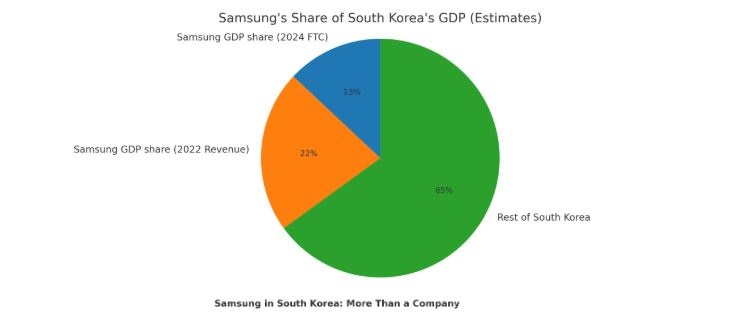South Korea is often called the “Republic of Samsung.” That phrase isn’t just a meme. It reflects how chaebols — family-run conglomerates — dominate the country’s economy, politics, and even daily life.
Samsung started in 1938, trading dried fish, groceries, and noodles. Decades later, through state support and aggressive diversification, it transformed into a global tech powerhouse. Today, Samsung builds smartphones, semiconductors, ships, skyscrapers, TVs, hospitals, and even military tech.
This growth wasn’t random. It was part of South Korea’s chaebol system — a model that lifted the nation from post-war poverty to becoming a G20 export giant.

What are chaebols?
The term chaebol comes from the Korean words for wealth (chae) and clan (bol). They are family-controlled empires with multiple affiliates spanning industries like electronics, cars, finance, chemicals, and entertainment. They operate like ecosystems: vertically integrated, globally competitive, but also politically influential.
Major Chaebol Groups in South Korea
| Chaebol | Core Industries | Notable Points |
| Samsung Group | Electronics, semiconductors, appliances, construction, finance | Estimated 13–23% of GDP; world leader in chips & phones |
| SK Group | Energy, telecom, semiconductors, batteries | Big player in EV batteries & chips |
| Hyundai Motor Group | Cars, steel, construction, logistics | Includes Kia Motors; huge in exports |
| LG Group | Electronics, chemicals, displays, telecom | Rival to Samsung in consumer tech |
| Lotte | Retail, food, tourism, chemicals | Korea’s retail & food giant |
| Hanwha | Aerospace, defense, energy, insurance | Defense contracts & solar power |
| CJ Group | Food, logistics, entertainment, biotech | Popular in K-pop & media |
| Shinsegae | Retail, fashion, luxury malls | Major department store chain |
| Hanjin Group | Airlines, shipping, logistics | Owner of Korean Air |
Why chaebols are called “big ecosystems”
- They own supply chains from raw material to final product.
- They are vertically integrated, meaning they don’t just make parts — they also sell, ship, and finance them.
- They provide millions of jobs, directly and indirectly.
- They dominate exports, which is critical since Korea’s economy relies heavily on global trade.
- In some ways, they act like states within a state: with their own hospitals, schools, financial arms, and global networks.
Samsung alone is responsible for about 20% of South Korea’s exports. This means when Samsung performs well, the entire nation’s economy grows. When it struggles, the ripple effects hit banks, small suppliers, and jobs nationwide.
GDP Impact of Samsung:
Different studies calculate Samsung’s impact differently.
- 13% of GDP (2024, Fair Trade Commission – value added).
- 22–23% of GDP (2022 revenue comparisons).
- 20% of exports tied to Samsung.
- Millions of jobs supported, directly and indirectly.
Infographic Concept
- Pie chart: Samsung’s GDP share vs. rest of South Korea.
- Bar chart: Samsung’s exports (20%) compared to others.
- Icon chart: Jobs supported (millions).
- Timeline: 1938 dried fish → 2025 global tech empire.


Challenges & Criticisms
Chaebols are admired for driving growth but criticized for dominance and inequality.
- Governance problems: scandals, corruption trials, nepotism.
- Inequality: SMEs (small & medium enterprises) struggle against chaebol control.
- Over-dependence: If Samsung falters in chips, the national economy slows down.
- Social issues: job market concentration, limited upward mobility, political influence.
Reddit threads and Quora discussions reveal a divided view:
- Pride: “Samsung put South Korea on the global map.”
- Concern: “It feels like we live in a chaebol republic. They control too much.”
- Insight: Young Koreans often say innovation feels stifled because startups can’t compete with giants.
Final Take
Samsung is not just a company. It is the face of South Korea’s industrial rise, the anchor of its GDP and exports, and the core of its chaebol system. But the bigger the ecosystem, the bigger the risks. South Korea’s future depends on balancing chaebol power with new innovation, fair competition, and transparency. For now, Samsung is not only a brand. It is an empire inside South Korea.
Q1. What is a chaebol?
A chaebol is a large family-controlled conglomerate in South Korea with multiple affiliates across industries like electronics, cars, chemicals, finance, and retail.
Q2. How big is Samsung’s role in South Korea’s economy?
Samsung contributes 13% of South Korea’s GDP (2024 FTC) and, by revenue comparison, up to 22–23% (2022). It also makes up nearly 20% of total exports.
Q3. Which companies are considered chaebols in South Korea?
The biggest chaebols include Samsung, Hyundai Motor Group, SK Group, LG, Lotte, Hanwha, CJ Group, Shinsegae, and Hanjin Group.
Q4. Why are chaebols called “big ecosystems”?
Chaebols operate in many industries, often controlling the entire supply chain. For example, Samsung runs electronics, semiconductors, finance, insurance, construction, and healthcare, making it feel like a self-sustaining ecosystem.
Q5. What are the advantages of chaebols?
They drive exports, global competitiveness, R&D investment, and job creation, helping South Korea rise from a developing nation to a global tech leader.
Q6. What are the criticisms of chaebols?
Chaebols face criticism for governance scandals, monopolistic control, wealth inequality, and over-dependence. Many South Koreans worry that smaller startups can’t grow under their shadow.
Q7. Why do people call South Korea the “Republic of Samsung”?
Because Samsung’s size and influence are so massive that its success or failure directly impacts the national economy, exports, and even politics.
Want to see how Samsung’s mid-range phones are performing in 2025? Check out our detailed Samsung Galaxy A56 5G review.
If you’re interested in how tech giants influence economies beyond Korea, read our piece on the Vivo X200 Pro review.
Looking for budget-friendly alternatives outside the chaebol world? Explore our list of the Best Budget Smartphones 2025.
According to Braumiller Law, Samsung’s economic share once touched 23% of South Korea’s GDP.
The Korean Fair Trade Commission regularly monitors chaebol influence, releasing GDP and affiliate data.

